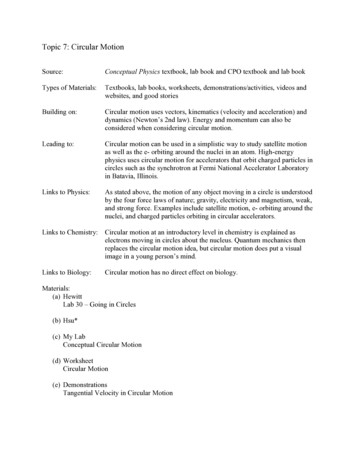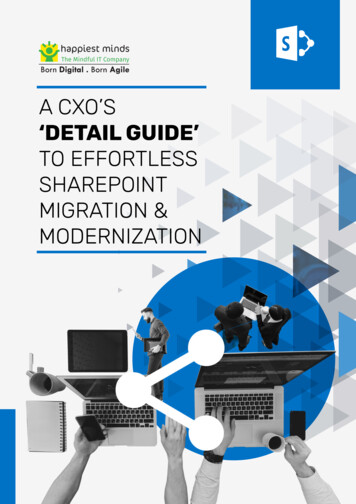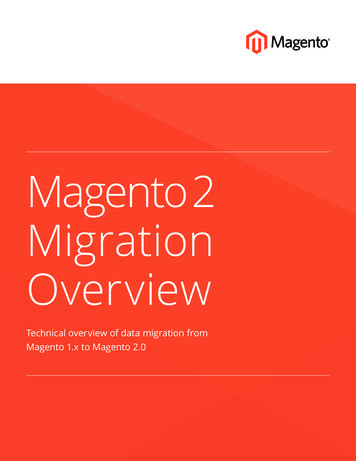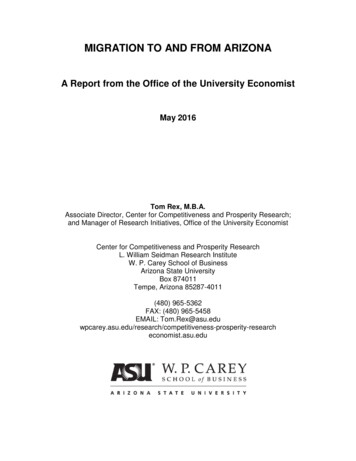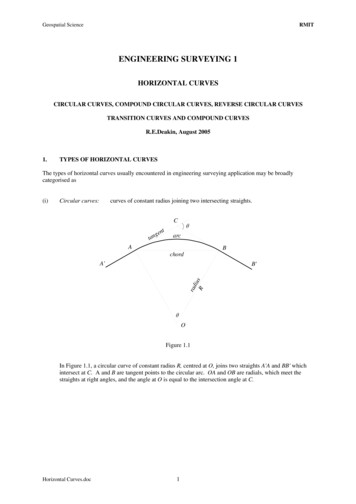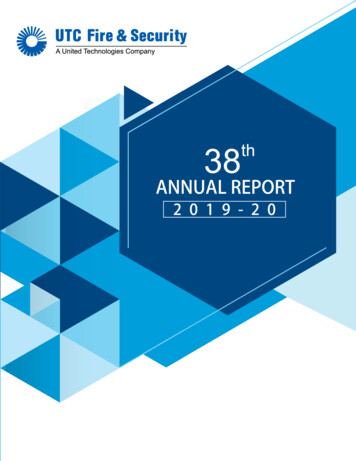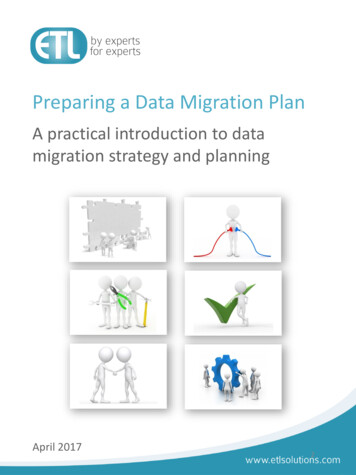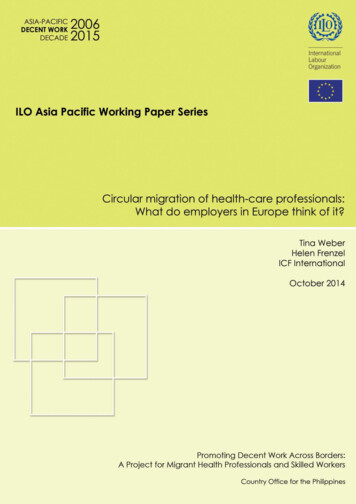
Transcription
ILO Asia-Pacific Working Paper SeriesCircular migration of health-care professionals:What do employers in Europe think of it?Tina WeberHelen FrenzelICF InternationalOctober 2014A report prepared for the EU-ILO Project onDecent Work Across Borders:A Pilot project for Migrant Health Professionals and Skilled Workers,Manila, PhilippinesCountry office for the PhilippinesI
Copyright International Labour Organization 2014Publications of the International Labour Office enjoy copyright under Protocol 2 of the Universal CopyrightConvention. Nevertheless, short excerpts from them may be reproduced without authorization, on condition thatthe source is indicated. For rights of reproduction or translation, application should be made to ILO Publications(Rights and Permissions), International Labour Office, CH-1211 Geneva 22, Switzerland, or by email: pubdroit@ilo.org. The International Labour Office welcomes such applications.Libraries, institutions and other users registered with reproduction rights organizations may make copies inaccordance with the licences issued to them for this purpose. Visit www.ifrro.org to find the reproduction rightsorganization in your country.ILO Cataloguing in Publication DataFrenzel, Helen; Weber, TinaCircular migration of health-care professionals: what do employers in Europe think of it? Helen Frenzel, TinaWeber; International Labour Organization, ILO Country Office for the Philippines. Makati City: ILO, 2014.ISSN: 2227-4391; 2227-4405 (web pdf)International Labour Organization; ILO Country Office for the Philippinesnurse/medical personnel/labour migration/return migration/international migration/migrant worker/ managementattitude/health service/EU countries13.11.2The designations employed in ILO publications, which are in conformity with United Nations practice, andthe presentation of material therein do not imply the expression of any opinion whatsoever on the part of theInternational Labour Office concerning the legal status of any country, area or territory or of its authorities, orconcerning the delimitation of its frontiers.The responsibility for opinions expressed in signed articles, studies and other contributions rests solely with theirauthors, and publication does not constitute an endorsement by the International Labour Office of the opinionsexpressed in them.Reference to names of firms and commercial products and processes does not imply their endorsement by theInternational Labour Office, and any failure to mention a particular firm, commercial product or process is not asign of disapproval.ILO publications and electronic products can be obtained through major booksellers or ILO local offices inmany countries, or direct from ILO Publications, International Labour Office, CH-1211 Geneva 22, Switzerland.Catalogues or lists of new publications are available free of charge from the above address, or by email: pubvente@ilo.orgVisit our website: www.ilo.org/publnsPrinted in the PhilippinesII
ForewordCircular migration has been hailed by many as a triple win solution to migration. It has been said tobenefit destination and source countries and migrant workers themselves. Many have welcomed theconcept as a process susceptible to increase the development benefits of labour migration.Beyond the theoretical discourse around the concept, the real appeal of circular migration remainsto be better understood. The concept remains a sensitive one, and is often understood differently bydifferent stakeholders across the migration continuum. The existing literature on the concept of circularmigration seems to remain at a rather general level and has, until recently, failed to investigate in greaterdetail the particular opinions of various stakeholders on the matter. More precisely, little information isavailable on the possible challenges and benefits the concept can bear from the view point of employers.The ILO is proud to contribute to the debate around circular migration by filling some of the gapsidentified by its European Union funded project called Decent Work Across Borders, a project focusingon the circular migration of health professionals between the Philippines, India and to some extent VietNam to selected destination countries in Europe. The ILO wishes that this new publication will expandthe knowledge on the subject and contribute to the international dialogue on circular migration bydocumenting the source and destination’s countries’ private and public employers’ perspective on theissue of circular migration.The ILO is grateful for the expertise of the Ms Tina Weber and Ms Helen Frenzel from ICF International,consultants to the International Labour Organization in the context of this research endeavour.Lawrence Jeff JohnsonDirectorILO CO ManilaIII
Table of contentForeword.iiiAcknowledgement.vExecutive Summary.vi1. Introduction.11.1 Background and purpose of the project.11.2 Aims and objectives of the study.21.3 Method.32. Circular migration of health-care workers: triple win, dead-end or myth.52.1 Definition and types of circular migration.52.2 Policy debate.62.3 Circular migration of health-care workers in Europe: the reality.152.4 Strengths, weaknesses, opportunities and threats of approaches tocircular migration for migrants, employers, origin and destination countries.323. Conclusions.37Bibliography.41Annex 1 Stakeholder questionnaires.46IV
AcknowledgementThe authors would like to thank all organisations who agreed to be interviewed for this study. Particularthanks are due to Catherine Vaillancourt-Laflamme, chief technical advisor for the ILO in Manila forher insightful comments and improvements in the drafting of this report.V
Executive summaryThis paper captures the findings of a study on employer views regarding the importance and feasibilityof the implementation of circular migration policies. It is based on desk review and interviews withemployers’ organisations, individual employers, public employment services and ministries and agenciesresponsible for co-ordinating international migration of health-care personnel. Interviews focussed onthe experience in a selected number of countries (Finland, Germany, Ireland and the United Kingdom),which are among the destination countries for health-care professionals from the Philippines and India.It discusses the development of the policy debate around the concept of circular migration and contraststhis with the reality on the ground.Circular migration as a panacea to address any negative impacts of the international migration ofhealth-care professionals?International migration of health-care professionals is by no mean a new phenomenon, but increased inintensity over the last decade as the impact of demographic change in many European countries led to anincrease in demand for health-care services, while at the same time reducing the supply of labour. Whilelabour demand has been affected by budgetary cuts in some countries in the years following the financialcrisis and economic recession, in future it is likely that long-term demographic trends in Europe willmean that demand for foreign labour will remain a future of health-care systems.Increases in migration flows have brought greater attention from policy makers on the positive, as wellas the negative economic and social effects of migration. As awareness of the potential negative impactof migration for origin countries (e.g. brain drain), but also destination countries (e.g. issues aroundintegration, discrimination, issues around the recognition of training and experience acquired in othercountries etc.) has grown, there have been efforts to formulate policies to address such impact. Thisincludes guidelines and codes or practice on ethical migration. In the European Union and a number ofits member countries, this has led to the promotion of the concept of circular migration. While differentdefinitions have been used to describe the concept, it essentially captures the idea of temporary, repeatmigration, which would allow destination countries to benefit from the opportunity to fill labour and skillsgaps, whilst encouraging/ensuring that foreign skilled workers return to their country of origin, havingbenefited from further training and work experience, thus enriching the health-care systems of the origincountries. As such, the model has been promoted as a “win-win-win” scenario. However, this conceptof the “triple win” has been questioned in a number of studies. Most prominently, Wickramasekara(2011) sees it as an extension of the desire by destination countries to bring in “labour” but not “people”,thus limiting potential benefits to migrants as well as origin countries. He argues that the emphasis onflexibility in approaches to managed migration only reflects the desire of destination countries to beable to use migrants as a way of meeting significant labour shortages, without the need for integrationmeasures, as the flow of such migrants can be restricted and those who have already arrived can be senthome when demand declines.In response to such criticisms, some countries have assessed their managed migration policies to ensure,for instance, longer periods of stay; the possibility of multi-entry visas; ensuring support for integrationin the destination countries, as well as support with re-integration in the countries of origin. However,what has been almost entirely ignored in this discussion is the reality of migration on the ground and,crucially, the views of employers who are ultimately the source of demand for such labour.VI
The reality of circular migration: more fiction than factDesk research and interviews carried out for this study show that circular migration among health-careprofessionals coming to Europe is more of a myth than a reality.Consultations with employers and government representatives demonstrate that even in managedmigration policies, little emphasis is currently being placed on supporting the notion of circularmigration, with more efforts expended to ensure ethical recruitment and the managed integration ofmigrant workers in the sector.Where there have been efforts to introduce circular migration schemes in Europe (in the health-caresector and beyond), these are largely in their infancy or proved (as in the case of the Blue Birds schemein the Netherlands) to be ultimately unsuccessful.The main reason for this lies rooted with the interests and motivations of employers in the sector, whosemain priority is to attract a highly qualified workforce to deliver a good and reliable standard of care totheir patients in an effective and efficient way.While there is some interest in transnational recruitment where relevant qualified workers cannot befound locally -- and a positive message from this study is that there is indeed growing awareness andwillingness to respect codes of conduct on ethical recruitment -- there is generally little interest in timelimited recruitment of highly qualified workers. This is particularly true where the upfront investmentin achieving the recognition of foreign qualifications and in integration measures is significant. Theshortage of highly skilled labour in the health-care sector in many countries tends to be structuraland employers are therefore keen to retain workers. Where there is a willingness to invest in trainingand integration this is very much targeted at retention rather than letting staff take these skills toother employers or abroad after a period of time. Understandably, employers therefore do not pursuedevelopment goals, but are concerned with the delivery of high quality health care to their patients.While governments may have wider interests and seek to foster circular migration, these interests rarelycoincide with those of employers in the health-care sector. The literature has previously emphasisedthat circular migration may appear more attractive to lower-skilled sectors and where demand is moreseasonal.To make circular migration more attractive for employers, it is important for more rapid and reliableprocesses for the recognition of qualification to be in place and for government support to be offered forthe integration of migrants (thus reducing the overt and hidden costs of integration). A clear integrationof all stakeholders into managed migration policies, going hand-in-hand with greater emphasis on clearmonitoring of labour demand and workforce migration strategies, would ensure that demand for suchmigrants does not necessarily become permanent.Such requirements can only be achieved through managed migration policies ensuring close co-operationbetween origin and destination countries, including the contribution of actors relevant to the health-caresector. Those include government, employers, trade unions and also professional organizations andrecruitment agencies. At present, it appears that such all-inclusive design and management of migrationsystems remains limited, and even where they exist (e.g. Germany) they currently do not ultimately aimat circular migration. The number of participants in such managed migration programmes would haveto be rather significant to help to create the momentum for change and to have a relevant economicimpact. It has therefore been suggested that it would be beneficial if several European Union countriesVII
would receive professionals. This kind of programme could be steered by the European Commission.To make the return home for participants easier and more attractive, it must be ensured that they returnto key positions to integrate their knowledge, again requiring greater co-operation between differentstakeholders in destination countries and countries of origin.About the authorDr Tina Weber (tina.weber@icfi.com) is a Technical Director at ICF International. Her expertisecovers European and national labour market policy, industrial relations and social dialogue,sectoral employment and policy trends (including specifically in the health-care sector), welfarepolicies and their impact on migration trends, as well as equal opportunities policy.Helen Frenzel (helen.frenzel@icfi.com) is a Consultant at ICF International. Her expertise liesin European and national labour law and studies of sectoral employment and policy trends.This publication has been produced with the assistance of the European Union. The contentsof this publication are the sole responsibility of Tina Weber and Helen Frenzel, consultant tothe International Labour Organization, and can in no way be taken to reflect the views of theEuropean Union.VIII
1. Introduction1.1 Background and purpose of the projectThis report is prepared for the International Labour Organisation (ILO) within the context of its DecentWork Across Borders: A Pilot Project for Migrant Health Professionals and Skilled Workers, whichhas been under way since 2011 with funding from the European Union (EU). The project seeks tobetter understand schemes in line with circular migration of health professionals by engaging withgovernments, trade unions and employers’ organisations around three main objectives: To strengthen mechanisms of policy dialogue among stakeholdersTo strengthen employment services for health-care professionals and skilled workersTo enhance labour market information systems with regard to the migration of health-careprofessionals and skilled workersThe overarching goal is to facilitate an approach to migration that benefits the migrant worker, theorigin and the destination countries within a rights-based framework for labour migration management.The project has a particular focus on health-care workers from the Philippines, India and Vietnam.The ILO is the United Nation’s international organisation responsible for drawing up and overseeinginternational labour standards. Integral to its mandate is to protect migrant workers1. The ILO haspioneered international conventions to guide migration policy and protection of migrant workers,specifically Convention No. 97 (Migration for Employment Convention, 1949) and Convention No.143 (Migrant Workers’ Convention, 1975). Further, in 2006, the ILO Multilateral Framework onLabour Migration was adopted in response for demands for practical guidance and action with a viewto maximising the benefits of labour migration for all parties.International migration among health-care professionals is not a new phenomenon, but migrationflows of workers in this sector have increased significantly in recent years and are attracting moreattention from policy makers because of their economic and social effects (both positive and negative).As awareness of the potential negative impact of migration for origin countries (e.g. brain drain), butalso destination countries (e.g. issues around integration, discrimination, the recognition of training andexperience acquired in other countries etc.) is growing, there have been efforts to formulate policiesand guidelines on ethical migration. Examples are the Global Code of Practice on the InternationalRecruitment of Health Personnel issued by the World Health Organisation in 2010, the CommonwealthCode of Practice for the International Recruitment of Healthcare Workers (2003) applicable to allemployers (private and public, and recruitment agencies) in the 53 Commonwealth countries, as wellas at 2008 the European level with the Code of Conduct on Ethical Cross Border Recruitment andRetention agreed by HOSPEEM and EPSU. At the national level, examples are the Code of Practice forInternational Recruitment for NHS Employers in the United Kingdom.1This mandate was reaffirmed by the 1944 Declaration of Philadelphia and the 1998 ILO Declaration on Fundamental Principles andRights at Work.Country Office for the Philippines1
The EU and a number of its Member States have sought to address this issue by promoting the conceptof circular migration. While different definitions have been used to describe the concept, it essentiallycaptures the idea of temporary, repeat migration, which would allow destination countries to benefitfrom the opportunity to fill labour and skills gaps, whilst encouraging/ensuring that foreign-skilledworkers return to their country of origin, having benefited from further training and work experience,thus enriching the health-care systems of the origin countries. As such, the model has been promotedas a “win-win-win” scenario. However, the question of the benefits for all parties concerned is notuncontroversial, as well as the desirability of it.1.2 Aims and objectives of the studyThe project aims to increase the existing knowledge base on circular migration among health-careprofessionals in particular and the strengthening of policy dialogue on this issue.As indicated, circular migration has recently been heralded as a triple-win solution that can benefit bothdestination and origin countries, as well as migrant workers themselves. However, a clear definition orcommon understanding of how the concept can be implemented is yet to emerge.Similarly, despite the emphasis placed by policymakers on the promotion of the concept of circularmigration, little is known about how widespread the practice is in reality, including among health-careworkers. The same is true for its implications both for migrant workers and health-care employers bothin the origin and destination countries. A paper published by Wickramasekara (2011) argues that thereis little evidence that circular migration benefits -- or is indeed desired by -- migrant workers. Instead,it is seen as a way for employers to engage in flexible hiring and firing whilst saving on integrationcosts. He argues that circular migration can be used to “bring in labour, but not people” (p. 86) and thuscontributes to control population movements between countries. A critical interpretation of the use offacilitated circular migration schemes as a way to control migration, couched in terminology of triplewin benefits, has also been made by Cassarino (2013).The starting point for this project is the recognition that very little is known about the employers’perspective on circular migration and it is this gap that this study sought to address. A paper documentingtrade unions’ perspectives on circular migration was published in 2011. The goal was therefore to gatherthe views of public and private health-care employers and employers’ organisations to help foster afruitful policy dialogue on the issue.The focus of the study was on the migration of Filipino and Indian health-care professionals to Europe.Germany, Ireland and the United Kingdom were selected as case study countries, as they are among themain destination countries of health-care professionals from India and the Philippines. Information wasalso gathered in Finland, which has significant experience of the migration of health-care workers, andrelevant experience of circular migration in other EU countries with regard to employers’ perceptionswas also taken into account.The study supplements existing reviews of the literature on circular migration and gathered the viewsof health-care employers and employers’ organisations through interviews at various levels. The studyalso reviewed relevant government and workplace policies on the recruitment of health professionalmigrants in circular migration schemes. As a result of the review of the literature and stakeholder2Country Office for the Philippines
consultations, this document draws conclusions on reality of circular migration of health-care workersto Europe as they are impacted by the position of employers on this issue. The study provides policyrecommendations on measures able to entice employers to adopt practices in line with circular migration.1.3 MethodThe method for this study therefore involved a review of literature with a focus on employer positionsand specific governmental agreements on circular migration (see the bibliography for sources used)and interviews with transnational and national employers’ and workers’ organisations in the health-caresector; and public and private health-care employers themselves. The table below lists the number oforganisations contacted and the responses received. It proved particularly difficult to identify individualemployer to respond, particularly as they considered the subject to be of limited relevance to them, eitherbecause few migrant workers are used or because the concept of circular migration had no applicationin practice in their organisation. The latter is confirmed by other research findings (e.g. Brand, 2012).Other factors also impacted responses (or the lack thereof) from employers in the context of a projectfocussing on migration by health-care workers from the Philippines and India. All EU employers arerequired to recruit first among the EU/EEA health-care professionals to fill their positions. This is alsopolitically encouraged at the national and EU-level, taking into account the high unemployment rateof young people in Europe in the aftermath of the economic and financial crisis. Hence, internationalrecruitment did not seem to be a priority among employers during the time of study. Where circularmigration between EU countries was discussed as a policy issue, any evidence from such practices hasbeen taken into account for the discussion in this paper.A semi-structured questionnaire was used to carry out telephone or face-to-face interviews (seeAnnex 1 for the questionnaires used with different stakeholders). A cascading approach was used toidentify potential interviewees. International and European employers’ organisations and trade unionorganisations were contacted first, who provided some details of their members in the relevant studycountries. Subsequently, relevant ministries, public employment services and national employers’organisations were contracted and interviewed. These interviews were also helpful in identifyingrelevant employers known to have experience employing migrant workers.Country Office for the Philippines3
Table 1. Organisations consultedType of organisationNumber of contactsNumber of responsesInternational employers’ organisations53International trade union organisations42Government department21Individual employer31Academic expert11Employers’ organisations53Government department32Individual employer42Trade union nmental organisational1IrelandTrade union organisation11Employers’ organisation1Individual employer2Employers’ organisation1Individual employer1Academic expert223621UKTotal1The difficulty in identifying employers with relevant experience of employing migrant workers fromcountries outside the EU and particularly having experience of circular migration proved one of thebiggest challenges for this project. All employers contacted were asked about their views of circularmigration, even if they were currently not using such schemes. However, in the views expressed, theconcept of circular migration was often conflated with that of ethical migration (which many wereprepared and able to speak about). When the concept was explained, most employers considered this tobe of little relevance to them, as will be discussed in subsequent sections of the document.4Country Office for the Philippines
2. Circular migration of health-care workers:triple win, dead end or myth?This section contrasts the “theory” or the policy thinking behind circular migration with the realityof the extent to which it is currently practiced for health-care workers coming to work in selectedEuropean countries, and the views expressed by employers on the desirability of using circular migrationapproaches. Beginning with a definition of the concept and the evolution of the policy debate andmoving on to the reality of actual migration and migration policies, it shows a clear disconnect betweenthe policy rhetoric of circular migration and its reality.2.1 Definition and types of circular migrationDespite the increasing use of the concept of circular migration in policy discussions, there is no oneagreed-upon definition of the concept. Indeed, the definitions applied have evolved over the years andcan also be seen to reflect the perspective of the organisation formulating them. Essentially describingthe temporary movement of individuals between locations, usually with a repetitive character, thisterm has been used for some time to describe the temporary movement usually of migrant workerseither from rural area to cities or across borders. Wickramasekara (2011) describes circular migration as“temporary movements of a repetitive character either formally or informally across borders, usuallyfor work, involving the same migrants”. A distinction can be drawn between spontaneous circularmigration and regulated circular migration programmes.Indeed, a definition from the European Commission (2007) only refers to the latter and defines circularmigration as a form of “migration that is managed in a way allowing some degree of legal mobility backand forth between countries” (p. 8).The concept of circular migration has also been referred to as “brain circulation” combining the conceptsof “brain drain” and “brain gain”. “Brain circulation” refers in a broad sense to the movement of skilledworkers from and to a country. Yet brain circulation has also been used in the area of training andcareer development describing the exchange of trainees and scholars that seek an international workexperience to secure more advantageous employment conditions in their home country. This type ofbrain circulation can be observed -- to a limited extent -- for doctors or highly specialised nurses, butis not a significant feature in the migration of other health-care workers. There are a number of modelsof migration that have been described as “circular” or circuit based, but which do not always imply aregular or repeat return to the destination country.The existence of patterns of circular migration is not new, and the concept was used to analyse migrationfrom rural to urban areas within one country or cross-border migration. It has previously also beendescribed as a repeat, cyclical, seasonal or circuit based mode of migration. Germany tried to implementsuch a circular migration in the 1960s when inviting workers from southern Europe and Turkey to comeas “Gastarbeiter” (guest workers), implying that workers are received on a temporary basis only. Yetonce the wave of migration was stopped in 1973 due to the oil crisis, migrants
Frenzel, Helen; Weber, Tina Circular migration of health-care professionals: what do employers in Europe think of it? Helen Frenzel, Tina Weber; International Labour Organization, ILO Country Offi ce for the Philippines. Makati City: ILO, 2014. ISSN: 2227-4391; 2227-4405 (web pdf)

